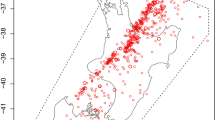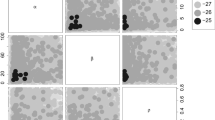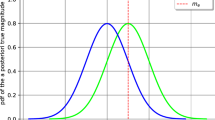Abstract
Point processes are the stochastic models most suitable for describing physical phenomena that appear at irregularly spaced times, such as the earthquakes. These processes are uniquely characterized by their conditional intensity, that is, by the probability that an event will occur in the infinitesimal interval (t, t+Δt), given the history of the process up tot. The seismic phenomenon displays different behaviours on different time and size scales; in particular, the occurrence of destructive shocks over some centuries in a seismogenic region may be explained by the elastic rebound theory. This theory has inspired the so-called stress release models: their conditional intensity translates the idea that an earthquake produces a sudden decrease in the amount of strain accumulated gradually over time along a fault, and the subsequent event occurs when the stress exceeds the strength of the medium. This study has a double objective: the formulation of these models in the Bayesian framework, and the assignment to each event of a mark, that is its magnitude, modelled through a distribution that depends at timet on the stress level accumulated up to that instant. The resulting parameter space is constrained and dependent on the data, complicating Bayesian computation and analysis. We have resorted to Monte Carlo methods to solve these problems.
Similar content being viewed by others
References
Benioff H (1951) Colloquium on plastic flow and deformation within the earth. Trans. Am. Geophys. Union32: 508–514
Camassi R, Stucchi M (1997) NT4.1.1 un catalogo parametrico di terremoti di area italiana al di sopra del danno. Gruppo Nazionale per la Difesa dai Terremoti, Milano, 1997, 95 pp., available from http://emidius.mi.ingv.it/NTurl
Chen M-H, Shao Q-M (1998) Monte Carlo methods for Bayesian analysis of constrained parameter problems. Biometrika85: 73–87
Gelman A, Roberts G O, Wilks W R (1996) Efficient Metropolis jumping rules. In: Bernardo J M, Berger J O, Dawid A P, Smith A F M (eds.) Bayesian statistics 5, pp. 599–607. Clarendon Press: Oxford
Liu J, Chen Y, Shi Y, Vere-Jones D (1999) Coupled stress release model for time-dependent seismicity. Pure and Applied Geophysics155: 649–667
Meletti C, Patacca E, Scandone P (2000) Construction of a seismotectonic model: the case of Italy. Pure and Applied Geophysics157: 11–35
Peruggia M, Santner T (1996) Bayesian analysis of time evolution of earthquakes. Journal of the American Statistical Association91: 1209–1218
Smith B J (2000) Bayesian output analysis program—BOA Manual version 0.5.0 for UNIX S-Plus. Department of Biostatistics, School of Public Health, University of Iowa
Vere-Jones D (1978) Earthquake prediction: a statistician's view. J. Physics Earth.26: 129–146
Vere-Jones D (1995) Forecasting earthquakes and earthquake risk. International Journal of Forecasting11: 503–538
Vere-Jones D, Yonglu D (1988) A point process analysis of historical earthquakes from North China. Earthquake Research in China2: 165–181
Zheng X, Vere-Jones D (1991) Application of stress release models to historical earthquakes from North China. Pure and Applied Geophysics135: 559–576
Zheng X, Vere-Jones D (1994) Further applications of the stochastic stress release model to historical earthquake data. Tectonophysics229: 101–121
Author information
Authors and Affiliations
Rights and permissions
About this article
Cite this article
Rotondi, R., Varini, E. Bayesian analysis of a marked point process: Application in seismic hazard assessment. Statistical Methods & Applications 12, 79–92 (2003). https://doi.org/10.1007/BF02511585
Issue Date:
DOI: https://doi.org/10.1007/BF02511585




